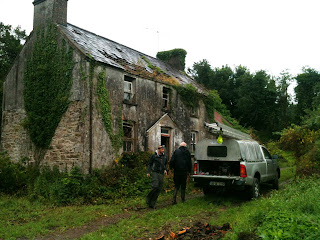A long and intense day of ringing at the Duhallow Barn Owl sites was tough going, not least because of the appalling weather, but also because most sites had no chicks. of 12 nest sites visited, only 2 had chicks, 5 chicks in total. A summary of the sites visited is shown below. The stark realisation is that it looks like they are having their worst breeding season to date.
• Tree nest near Newmarket – no signs at the nest, though birds have been seen nearby recently.
• Old cottage, NW Duhallow – Recent signs of owls, no chicks.
• Large derelict farmhouse, NW Duhallow – no signs, nest abandoned.
• Two story derelict farmhouse, NW Duhallow – 2 adults present, young possibly present, needs further investigation.
• Cottage near Newmarket, 2 adults present, 4 abandoned eggs found, no chicks.
• Tree nest near Newmarket – Three young.
• Old cottage near Rathmore – Recent signs of owls, no chicks.
• Quarry, Duhallow – at least 1 adult present, no chicks.
• Disused Cottage near Ballydesmond – recent signs of owls present at nest, no chicks.
• Derleict cottage near Ballydesmond – female present, no chicks.
• Nest box near Ballydesmond – Adult pair present, no chicks.
• Nest box near Ballydesmond – 2 chicks.
More on these sites soon.
2 of a brood of 3 chicks ringed today at a tree nest site in Duhallow today. The eldest chick on the left shows a considerable age difference to its youngest sibling, perhaps as much as 10-12 days. The lateness of this brood is also noteworthy – these youngsters won't be leaving the nest until late September, perhaps even October. (Photographed under licence: M.O'Clery).















